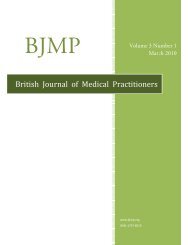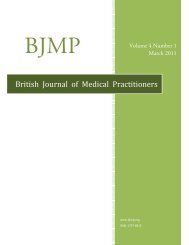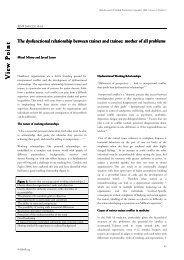R esearch A rticle - British Journal of Medical Practitioners
R esearch A rticle - British Journal of Medical Practitioners
R esearch A rticle - British Journal of Medical Practitioners
You also want an ePaper? Increase the reach of your titles
YUMPU automatically turns print PDFs into web optimized ePapers that Google loves.
<strong>British</strong> <strong>Journal</strong> <strong>of</strong> <strong>Medical</strong> <strong>Practitioners</strong>, March 2013, Volume 6, Number 1<br />
BJMP 2013;6(1):a608<br />
Clinical Practice<br />
Irritable Bowel Syndrome for Primary Care Physicians<br />
Ali Khanbhai and Daljit Singh Sura<br />
Introduction and Epidemiology<br />
Irritable bowel syndrome (IBS) is a chronic and <strong>of</strong>ten<br />
debilitating condition with a complex aetiology 1 . It is the most<br />
common diagnosis made by gastroenterologists worldwide 2 .<br />
The incidence and prevalence <strong>of</strong> IBS vary depending on the<br />
diagnostic criteria used but it is estimated that the prevalence in<br />
the UK is 17% overall, with a prevalence <strong>of</strong> 11% among men<br />
and 23% among women 3-4 . IBS can have a significant negative<br />
impact on quality <strong>of</strong> life and social functioning, although it is<br />
not known to be associated with the development <strong>of</strong> serious<br />
disease or excess mortality. However, patients with IBS are<br />
more likely to undergo specific surgical operations such as<br />
hysterectomy and cholecystectomy. IBS further represents an<br />
economic burden on society due to the high consumption <strong>of</strong><br />
healthcare resources and the non-productivity <strong>of</strong> IBS patients 5 .<br />
It appears that 33–90% <strong>of</strong> patients do not consult a physician,<br />
and that a proportion <strong>of</strong> patients who meet the IBS criteria are<br />
not diagnosed with IBS. The frequency <strong>of</strong> IBS symptoms peaks<br />
in the third and fourth decades, and there is a female<br />
predominance <strong>of</strong> about 2:1 in the 20s and 30s, although this<br />
discrepancy is less apparent in older patients 6 . The female<br />
predominance is less apparent in the general population, which<br />
suggests that women with IBS are more likely to seek healthcare<br />
for their symptoms 7 . IBS symptoms which persist beyond<br />
middle life continue to be reported by a substantial proportion<br />
<strong>of</strong> individuals in their seventh and eighth decades.<br />
Pathogenesis<br />
The pathogenesis <strong>of</strong> IBS appears to be multifactorial. The<br />
following factors play a central role in the pathogenesis:<br />
heritability and genetics, dietary and intestinal microbiota, lowgrade<br />
inflammation and disturbances in the neuroendocrine<br />
system <strong>of</strong> the gut 2 .<br />
IBS is known to aggregate in families and to affect multiple<br />
generations but not in a manner consistent with a major<br />
Mendelian effect. Relatives <strong>of</strong> an individual with IBS are two to<br />
three times as likely to have IBS 8 .<br />
Psychological distress is not only a common co-morbidity in<br />
IBS patients, but also a factor which is likely to play a direct<br />
role in the pathogenesis 4 . Interestingly, parental modelling and<br />
the reinforcement <strong>of</strong> illness behaviour can also contribute to<br />
IBS. Having a mother with IBS has been shown to account for<br />
as much variance as having an identical set <strong>of</strong> genes as a co-twin<br />
who has IBS. This insinuates that the contribution <strong>of</strong> social<br />
learning to IBS is at least as great as the contribution <strong>of</strong><br />
heredity. Furthermore, the role <strong>of</strong> childhood events such as<br />
nasogastric tube placement, poor nutrition, abuse, and other<br />
stressors have been clearly associated with IBS 8 .<br />
A substantial proportion <strong>of</strong> patients with IBS report onset <strong>of</strong><br />
their symptoms after acute gastroenteritis 9 . Post-infectious (PI)-<br />
IBS has been reported after viral, bacterial, protozoa and<br />
nematode infections, with the incidence <strong>of</strong> PI-IBS varying<br />
between 7% and 31%. In this subset <strong>of</strong> IBS patients GI<br />
symptoms appear following gastroenteritis, with approximately<br />
10% developing persistent symptomsRecent studies suggest that<br />
some individuals are genetically predisposed to developing PI-<br />
IBS, with some people demonstrating a specific cytokine<br />
response to infection 4 .<br />
It is important to note that women appear to have more<br />
frequent and severe IBS symptoms during menses compared to<br />
other phases <strong>of</strong> the menstrual cycle and that female gender is a<br />
significant independent risk factor for the development <strong>of</strong> IBS 7 .<br />
Diagnosis and Investigations<br />
Adult patients who present to their general practitioner (GP)<br />
with lower gastrointestinal tract disorders account for one in 20<br />
<strong>of</strong> all general practice consultations. The possibility <strong>of</strong> sinister<br />
conditions such as colorectal cancer or inflammatory bowel<br />
disease may create diagnostic uncertainty and reluctance for the<br />
doctor to attribute the symptoms to IBS. In the United<br />
Kingdom up to 29% <strong>of</strong> patients with IBS are referred to a<br />
specialist but the majority <strong>of</strong> these will return to their GP for<br />
long term management 6 .<br />
Primary care differs from specialist care because the GP’s greater<br />
familiarity with the patient, and their previous consultations,<br />
enable presenting problems to be seen in context rather than in<br />
isolation. Furthermore, it involves the first contact for care <strong>of</strong><br />
problems at a stage when they are likely to be poorly defined.<br />
Lastly, primary care is characterised by a biopsychosocial model<br />
<strong>of</strong> care that takes into account the context <strong>of</strong> the person’s<br />
BJMP.org<br />
34







